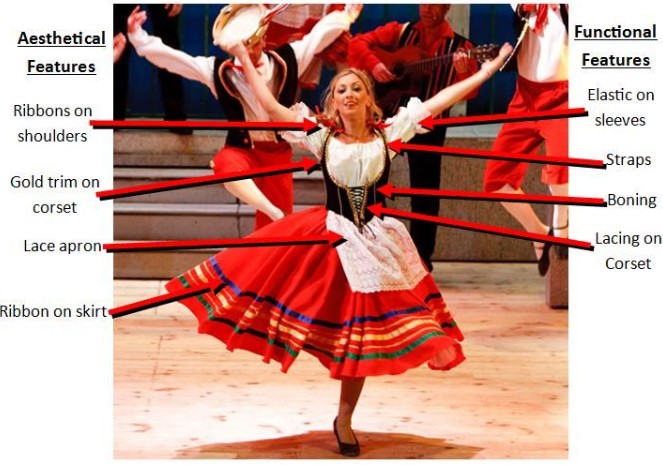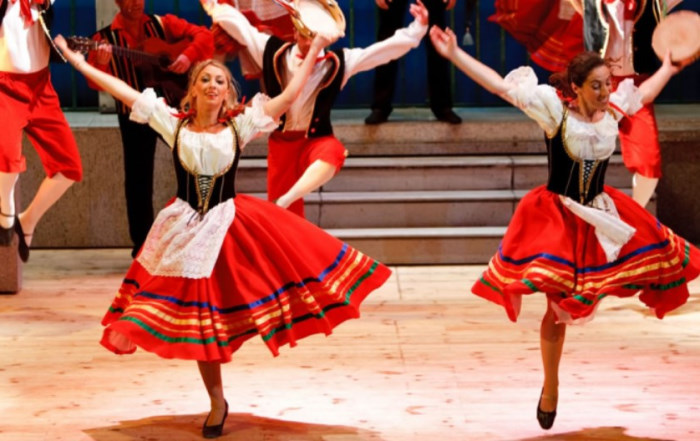Even if you haven’t heard of it before or don’t yet know what it is, the name Tarantella sounds fun, isn’t it?
And sure enough, the Tarantella dance – originating from Italy – has claimed itself a place in the heart of many choreophiles.
The fast, lively moves combined with the rhythmic beat of the tambourines make this dance truly stand out in the list of folk dances around the world.
Interested? In this article, we’ll show you everything that you need to know about the Tarantella dance and more!
Table of Contents
What Is Tarantella Dance?
In its simplest form, the Tarantella dance is an Italian folk dance characterized by the quick, light steps of the dancers. It’s also filled with one element that Italy is known for, as well: romance.
The dance partners would move evocatively and flirtatiously around one another, their body language inviting and sensual.
The female dancers in Tarantella will usually perform with a tambourine in hand, tapping to the rhythm.
Tarantella is a fast-paced dance, often performed at 6/8 time.
Tarantella Dance History
The word (and according to some sources, the dance itself) originates from the province of Taranto, Apulia, located in the sunny south of Italy.
Back in the day, this region was known to be a breeding ground for a kind of wolf spider known as Tarantulas.
While they look big, hairy, and definitely scary (one can be as big as a dinner plate!), we now know that Tarantulas actually aren’t venomous, but people back then didn’t.
They thought that the bites of Tarantulas caused people to go into a frenzy, known as tarantism.
It was believed that when the victims were bitten, the only way they could be cured was by frantically dancing.
So, that turns out to be the original purpose of the Tarantella dance: not a dance for dance’s sake, but, surprisingly, a medical treatment.
Over time, the word tarantism turns into Tarantela … and here we are!
Tarantella Dance Steps
Looking to learn the Tarantella dance? Well, look no further!
The fun part about this dance is that it is super versatile. You can dance solo (individually) or dance with partners (coupled or group).
This segment will show you how to do all forms.
Dancing solo
Performing solo is usually what most people will start with, especially if you practice at home by yourself and don’t go to a dance studio.
Here are the steps.
Step 1: Gather the instruments
The Tarantella dance is intimately linked with the tambourine. It’s a rhythmic dance, after all.
So, if you plan to dance by yourself, it’s important that you have your instrument: a tambourine.
Fortunately, tambourines are extremely easy to use (just tap it!) and they’re also quite cheap.
It’s not like guitars or violins where you have to take courses for years before you become competent. You’ll get the hang of it in a couple of minutes, max.
Step 2: Skip counterclockwise
On the first count, skip counterclockwise while tapping your instrument. The skipping will go on for 16 beats (make two eight-counts). With each beat, tap your instrument once.
Step 3: Skip clockwise
After the initial 16 beats are through, do the same skipping motion, but this time, clockwise. Also, make 16 skips clockwise and tap your instrument to the beat as you do.
Step 4: Step back and forth
Once you’re done with the turns, make two steps forward, then take two steps back. Put the bottom of your right heel against the ground, using your left foot as support. Do this move for counts 1 to 2.
For counts 3-4, place the ball of your right foot behind you.
Step 5: Rotate counterclockwise
Push yourself into a counterclockwise rotation using your right foot while keeping your left foot firmly planted on the ground.
Keep rotating through counts 5, 6, 7, and 8. Stop when you return back to your starting position.
With each rotation, tap your tambourine.
Step 6: Repeat the motion on your left side
Do the exact same motions as described above, including the forward and backward steps and the rotation.
But use your left foot this time and for the rotating part, you must rotate clockwise instead of counterclockwise.
Step 7: Perform knee drivers on your right
Bring your tambourine high up into the air, then take a step back with your right foot.
On the next count, bring your tambourine down and tap it against your right thigh as you bring up your knee in front of you.
Bring your right knee down and put your right foot behind you.
Repeat this motion three times.
Step 8: Perform knee drivers on your left
Repeat this motion, only with your left leg rather than your right. Also, repeat it three times.
Step 9: Repeat the knee drivers on each side one last time
Once you have done three reps of knee-drivers on your left side, turn to your right and do it four times with your right leg. Then, turn and do it four times with your left.
Step 10: Start from the top!
That completes the solo dance cycle! Start from the first step and keep going through the motion until the music stops.
Dancing with Partners
Dancing the Tarantella with a partner is quite similar to dancing solo. Once you have mastered the art of solo-dancing the tarantella, you’ll get the hang of the couple variant in no time.
Step 1: Pick up a tambourine
Both partners should have a small tambourine with them.
Step 2: Cross-step or shake your tambourine
The dance starts with both partners facing one direction and standing next to each other.
If you assume the female dancer’s part, then start to shake your tambourine and dance in a clockwise circle to the rhythm of the music.
On the other hand, if you assume the male’s part, then you need to do a cross-step.
For counts 1-2, cross your right foot over your left. Then cross your left foot over your right on counts 3-4. On counts 5-6, step out using your right foot, then do the same thing with your left foot on counts 7-8!
Before we begin further, though, a small tip. Anyone – regardless of sex or gender – can opt to play either role. It’s down to your preference and how you divvy up the roles between yourself and your partner.
Here, we only discuss it as a “male” or “female” part simply because they’re steps traditionally performed by that particular sex.
Step 3: Do the Tarantella step
Both partners will perform this step as in sync as they can.
Put your hands on your hips. Then, on count 1, kick your foot out and low to the ground.
On count 2, place the ball of your right foot against the ground in front of your left foot.
For count 3, make a short hop backward and onto your left foot.
And for count 4, hop forward again and onto your right foot, ending up at your starting position.
Next, repeat the sequence above but with your left foot instead of your right foot. After that, repeat the whole sequence 3 more times, using 8-counts.
Step 4: The Tambourine Triangle
Turn around and face your partner.
If you’re assigned to the female part, on count 1-2-3, tap your tambourine against your left shoulder, your left hip, then your right hip.
Repeat the motion on counts 4-5-6. For the last counts 7 and 8, tap the tambourine with your hands two times.
The male part is rather simple: stand there and gyrate slightly to the rhythm of the music.
Step 5: Do the “do-si-do”
For the do-si-do, both partners should dance the Tarantella steps (detailed above) forward, passing each other. Then, perform two steps backward so that you end up back at your starting position.
Repeat the tambourine triangle, then do the do-si-do again before moving on to the next step.
Step 6: Kneel or perform the Tarantella steps 4 times
The “male” partner will kneel down on their right knee, then tap their tambourine against their side for 7 beats (1-2-3-4-5-6-7). On the last beat – count 8 – they will tap it twice.
The “female” partner will perform the Tarantella steps in place 2 times.
Step 7: Continue the motion
The same motion above will continue for the next 16 counts.
The male partner will remain on their knee, tapping their tambourine above their head. Meanwhile, the female partner will flourish in a clockwise circle around them and perform 4 Tarantella steps.
Start from the beginning!
Tarantella Dance Costume

Because the Tarantella dance is a folk dance, it should ideally be danced with the traditional costume of the people from the region.
For women, the costume involves a white, gathered skirt with a white apron. An embroidered scarf is usually tied around the neck.
As for the men, they will wear three-quarter pants, a black vest, along with a small cap.
Everyone will wear special shoes made for dancing.
Tarantella Music
Tarantella music is typically written in 6/8 form and has rapid, upbeat energy. The tambourines used by each dancer will accentuate the sound, making it even more frantic.
Some have described the sound as “manic,” and indeed, the dance was created as a cure for what was thought to be a deadly and poisonous spider bite!
FAQs
When was the Tarantella dance created?
Like most folk dances, the exact time or person who created the dance (so far) isn’t known. All we know is that it started in the late 14th century in southern Italy.
When is the Tarantella dance performed?
Tarantella is often performed at joyous events in the community. You’ll see the dance at weddings, birthdays, and such. Couples or groups will also be dancing at local folk or culture fairs, expos, and dance competitions.
What does the Tarantella dance symbolize?
It’s most commonly associated with tarantism, a supposedly deadly disease caused by the bite of a tarantula spider.
When someone “catches” this disease, it is believed that they must frantically dance the poison “off”; else, they’ll die.
It’s the reason why the Tarantella is also called “The Dance of the Spider.”
Later, it was found that the tarantula spider wasn’t venomous. Instead, there are now two more “scientific” explanations for this disease.
One was a type of mass hysteria called the dancing mania, which can cause thousands of people to break into wild dances at once.
The other explanation placed the blame not on the bite of the tarantula but on another spider that was also very popular in the region back then: the Mediterranean black widow. The bite of this spider is extremely venomous and could kill if not treated.
But, unfortunately, you can’t dance the bite of the Mediterranean black widow off. So now, the importance of Tarantella dance mostly boils down to the cultural value it gives to the people in the area.
Check more about tradition Indian dance – Kathak Dance
Final Words
The Tarantella dance is a wonderful dance with a pretty interesting history. It’s hard to believe such a joyful, spirited dance was once associated with near-certain death!
If you ever have the opportunity to visit southern Italy, visit some of the events or fairs there and you’ll see people dancing the Tarantella with your own eyes.
Or, if you would like to give it a shot yourself, use the guide above to get started!

This website was very helpful 😉 I passed Harvard after learning this